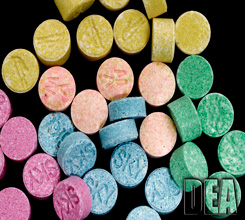MDMA acts as both a stimulant and psychedelic, producing an energizing effect, distortions in time and perception, and enhanced enjoyment of tactile  experiences. Adolescents and young adults use it to reduce inhibitions and to promote: euphoria, feelings of closeness, empathy, and sexuality. Although MDMA is known among users as Ecstasy, researchers have determined that many Ecstasy tablets contain not only MDMA but also a number of other drugs or drug combinations that can be harmful, such as: methamphetamine, ketamine, cocaine, the over-the-counter cough suppressant dextromethorphan (DXM), the diet drug ephedrine, and caffeine. In addition, other drugs similar to MDMA, such as MDA or PMA, are often sold as Ecstasy, which can lead to overdose and death when the user takes additional doses to obtain the desired effect.
experiences. Adolescents and young adults use it to reduce inhibitions and to promote: euphoria, feelings of closeness, empathy, and sexuality. Although MDMA is known among users as Ecstasy, researchers have determined that many Ecstasy tablets contain not only MDMA but also a number of other drugs or drug combinations that can be harmful, such as: methamphetamine, ketamine, cocaine, the over-the-counter cough suppressant dextromethorphan (DXM), the diet drug ephedrine, and caffeine. In addition, other drugs similar to MDMA, such as MDA or PMA, are often sold as Ecstasy, which can lead to overdose and death when the user takes additional doses to obtain the desired effect.
What are the street names?
Adam, Beans, Clarity, Disco Biscuit, E, Ecstasy, Eve, Go, Hug Drug, Lover's Speed, MDMA, Peace, STP, X, XTC
What does this drug look like?
MDMA is mainly distributed in tablet form. MDMA tablets are sold with logos, creating brand names for users to seek out. The colorful pills are often hidden among colorful candies. MDMA is also distributed in capsules, powder, and liquid forms.
How is this drug abused?
MDMA use mainly involves swallowing tablets (50-150 mg), which are sometimes crushed and snorted, occasionally smoked but rarely injected. MDMA is also available as a powder. MDMA abusers usually take MDMA by "stacking" (taking three or more tablets at once) or by "piggy-backing" (taking a series of tablets over a short period of time). One trend among young adults is "candy flipping," which is the co-abuse of MDMA and LSD. MDMA is considered a "party drug." As with many other drugs of abuse, MDMA is rarely used alone. It is common for users to mix MDMA with other substances, such as alcohol and marijuana.
How does this drug affect the mind?
MDMA mainly affects brain cells that use the chemical serotonin to communicate with each other. Serotonin helps to regulate mood, aggression, sexual activity, sleep, and sensitivity to pain. Clinical studies suggest that MDMA may increase the risk of long-term, perhaps permanent, problems with memory and learning. MDMA causes changes in perception, including euphoria and increased sensitivity to touch, energy, sensual and sexual arousal, need to be touched, and need for stimulation. Some unwanted psychological effects include: confusion, anxiety, depression, paranoia, sleep problems, and drug craving. All these effects usually occur within 30 to 45 minutes of swallowing the drug and usually last 4 to 6 hours, but they may occur or last weeks after ingestion.
How does this drug affect the body?
Users of MDMA experience many of the same effects and face many of the same risks as users of other stimulants such as cocaine and amphetamines. These include increased motor activity, alertness, heart rate, and blood pressure. Some unwanted physical effects include: muscle tension, tremors, involuntary teeth clenching, muscle cramps, nausea, faintness, chills, sweating, and blurred vision. High doses of MDMA can interfere with the ability to regulate body temperature, resulting in a sharp increase in body temperature (hyperthermia), leading to liver, kidney and cardiovascular failure. Severe dehydration can result from the combination of the drug's effects and the crowded and hot conditions in which the drug is often taken. Studies suggest chronic use of MDMA can produce damage to the serotonin system. It is ironic that a drug that is taken to increase pleasure may cause damage that reduces a person's ability to feel pleasure.
What drugs cause similar effects?
No one other drug is quite like MDMA, but MDMA produces both amphetamine-like stimulation and mild mescaline-like hallucinations.
What are the overdose effects?
In high doses, MDMA can interfere with the body's ability to regulate temperature. On occasions, this can lead to a sharp increase in body temperature (hyperthermia), resulting in liver, kidney, and cardiovascular system failure, and death. Because MDMA can interfere with its own metabolism (that is, its break down within the body), potentially harmful levels can be reached by repeated drug use within short intervals.
What is the legal status in the United States?
MDMA is a Schedule I drug under the Controlled Substances Act, meaning it has a high potential for abuse, no currently accepted medical use in treatment in the United States, and a lack of accepted safety for use under medical supervision.
What are the common places of origin?
MDMA is a synthetic chemical made in labs. Seized MDMA in the U.S. is primarily manufactured in, and smuggled across our borders from, clandestine laboratories in Canada and, to a lesser extent, the Netherlands. A small number of MDMA clandestine laboratories have also been identified operating in the U.S.